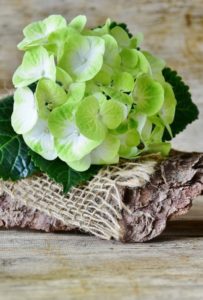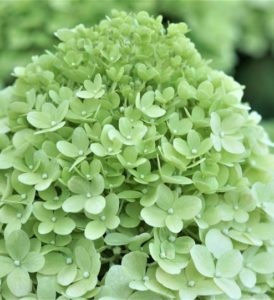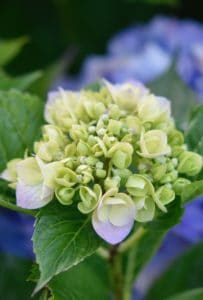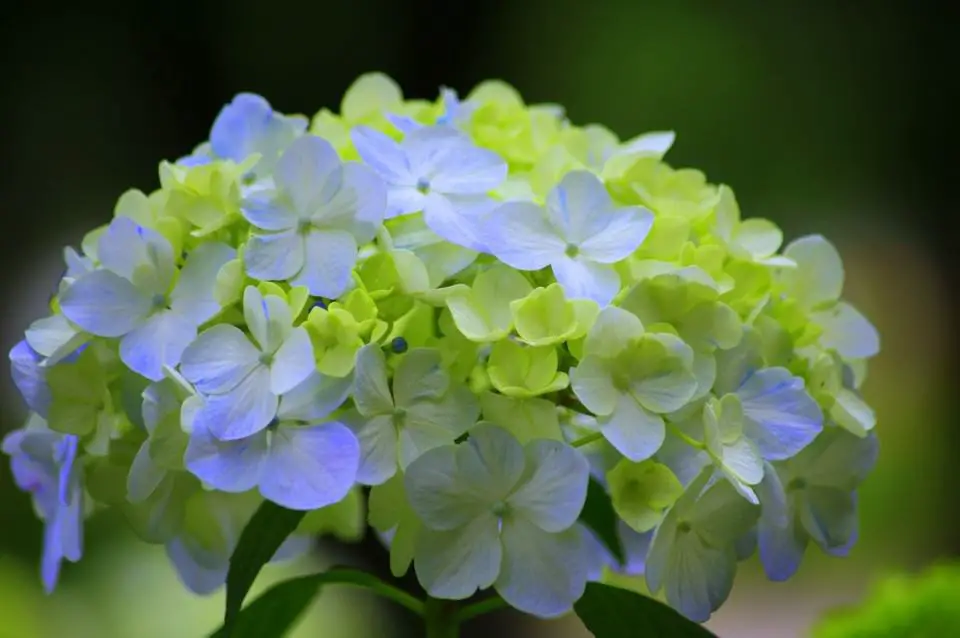Some links in the post are affiliate links and I get a commission from purchases made through some links found in the post.
We all look forward to colorful blooms on hydrangeas. They make for amazing landscapes, adorn interior spaces, and could be just what a home needs to look alive.
So, it’s normal to have concerns when they start turning green out of the blue. Is there a reason why the hydrangea flowers turn green? Is it normal? We answer these and more questions in this guide.
Why Are My Hydrangeas Turning Green?
Waking up to green blossoms is not what gardeners have in mind when they plant hydrangeas. But it happens. Why is that? Well, it can owe to a few reasons
The main reasons your hydrangea can be turning green is due to a reduced amount of light/ sunlight, part of it’s natural lifecycle of aging and high heat and humidity.
Aging
 Plants, just like humans, go through a life cycle. And part of that includes aging in preparation for the ultimate end. As this happens, the flowers start changing colors.
Plants, just like humans, go through a life cycle. And part of that includes aging in preparation for the ultimate end. As this happens, the flowers start changing colors.
So, they start off with their vibrant hues, then turn green. And as nature would have it, the blossoms eventually brown and die off.
When does this color change happen? Well, it follows a pattern. The blossom will be the original color at the start of summer- bright and vibrant.
Flowers are young at this stage. Then the end of summer draws near, and the flowers are much older by now.
So, they start becoming paler. And if the conditions are hot, they can even start showing signs of browning.
By the start of winter, the flowers have browned and dried. And that ends their chapter – Till the next bunch in the summer.
Reduced Access to Light
Hydrangea blooms depend on sunlight to produce pigmentation. At the start of summer, the blooms are quite vibrant.
After all, the intensity of the light is at a high. And the day lengths are quite lengthy. But as the end of summer draws close, the day lengths reduce.
As such, the blooms don’t get as much access to light. The result? – they lose their ability to produce pigmentation. And you end up with a green blossom.
High Heat and Humidity
Hydrangeas grow in canopies, where they thrive in the heat and humidity. So, one would expect that they would do well in a hot and humid environment.
But that’s not always the case. It turns out that when hydrangeas are in a hot environment, the root system faces challenges in drawing up enough water to account for the evaporated water from the leaves.
And that paves the way for dehydration, robbing the plant of the chance to make pigment for its flowers. So, they start turning green.
See? Your hydrangea’s change in color does not owe to a horrible issue that requires specialized intervention. Instead, it comes down to a few natural issues you can easily solve.
If you are enjoying this article, check out our article on why does my hydrangea have small flowers.
How To Prevent Your Hydrangeas Turning Green
The thought of green blossoms can have you searching for all sorts of ways to prevent such an occurrence. But is there anything you can do about this change in hue?
We recommend addressing each item rather than using a one-size-fits-all approach. So, let’s look at how this can work:
Aging
Unfortunately, aging is a natural process, and there’s nothing you can do about it. Some people often think that the soil pH is to blame, and they try to amend it.
And they are right because neutral soil can cause green flowers. But if the soil is okay and nothing seems to be amiss, then aging is the core reason.
And there’s nothing you can do about it. So, keep providing your plant with its needs and marvel at the wonders of the plant life cycle.
Reduced Access to Light
We all know that most plants do well when exposed to sunlight. But should you move your hydrangea next to the window in the full glare of the sun?
Understandably, you would toy with such a move. However, you should remember that the hydrangea grows under a canopy in the wild.
As such, it does best with filtered light (bright indirect light). Thus, if you put it in direct sunlight, it will burn, damaging the flowers.
So, that’s a no to that option. What remains? – placing your plant where it can get at least 6 hours of sunlight a day. Ensure that the light is not direct.
The second suggestion lies in addressing the needs of the plant. You see, towards the end of summer, seed production takes precedence over flower coloration.
And when a plant is healthy and vibrant, it can serve both needs. But when it’s a bit weak, it favors seed production over flower pigmentation. The idea here is to provide the plant with everything it needs so it can meet both needs.
High Heat and Humidity

Who would have thought that humidity could affect a hydrangea? Let’s look at how we can solve this.
Heat – when the temperatures are too high, the plant loses a lot of water to the environment. And the roots cannot keep up with this loss.
So, what can we do about it? It’s easy – you move the plant to a cooler location. Steer clear from direct sunlight, heat vents, bathrooms, and kitchens. And instead, opt for cooler rooms in the house.
Humidity: Too much humidity can also be an issue. Is there anything we can do about it? Sure!
Look into what could be increasing the humidity in the room – humidifiers, open sources of water, open kitchen and bathroom doors, etc.
Then deal with each of these possible causes. Once the humidity is balanced, the plant should do much better.
The goal here in all these solutions is to reduce plant stress. That allows the hydrangea to progress with the blossom pigmentation process. So, what are the best practices to follow?
1) You must create an environment akin to the natural environment under canopies.
Hydrangeas are native to such conditions and will thrive in such a setting. So, set the plant in an area that receives bright indirect light like the filtered sun it gets under canopies.
2) You must water the plant regularly, achieving a balance between overwatering and underwatering. To know if the plant needs water, check the top two inches of the soil before watering.
If they feel moist, you can wait a few more days. But if they are dry, you should water the plant. If you often struggle with this, get a moisture meter to help you gauge when it’s time to water the plant.
3) You must fertilize the soil in the spring with a balanced fertilizer. Natural and synthetic options are viable.
However, you must ensure that you balance between too much and too little feeding. Also, do not feed the plant during its dormant months.
4 )You must invest in a good potting mix. We recommend adding peat or compost to the pot to allow enough drainage. That can help you prevent issues like waterlogging and root rot.
And most importantly, you must be patient. Once you have adopted a method to prevent your hydrangeas from turning green, give it time to work. Using too many approaches at the same time can stress the plant.
Are There Hydrangeas That Are Green?
Did you know? Some hydrangea varieties boast green flowers. Thus, if you have these in your garden, you should expect green blossoms when the time comes. These varieties include:
- Limelight: This species grows to a height of three feet and, as the name suggests, gives rise to lime-colored blossoms.
- Little Lime: If three feet in height seem like too much for your home, you can plant this species that reaches two feet. Like Limelight, it also gives rise to green flowers.
So, if you’re looking for something out of the norm, these and more species would be a great place to start.
Can You Revert the Green Hydrangea Back to Its Original Color?
Suppose you have woken up to find the garden filled with your hydrangeas turning green. Of course, you would want to find a solution to revert their hues immediately. But can you do it?
Unfortunately, no! Once the hydrangeas start turning green, that indicates that your plant is either:
- Aging,
- Not getting adequate light, or
- Struggling with too much heat and/or humidity.
In two of these cases (excluding age), you must address the underlying problem. How? – By replicating the hydrangea’s natural environment like we earlier discussed. Then, all that remains is playing the long game by waiting for the results.
Will this change the color of the hydrangea? It will not affect the flowers that have already turned green.
However, it’s a neat way to prevent the other flowers from turning green. Keep in mind that it takes a while for the results to show. Also, with reasons such as aging, there’s nothing you can do to revert the changes.
Should I Cut Off Green Hydrangea Blooms?
You could consider cutting off the green blooms to pave the way for brighter blossoms. But will it work?
Cutting off the blossoms will enable the plant to produce much bigger ones. However, that might not solve the color issue. After all, it comes down to the plant’s condition.
For example, if the change in hue owes to reduced light, the blossoms will still be green.
Thus, you must accompany deadheading flowers with providing the plant with its needs. That way, the resultant blooms will likely have a change in hue.
Final Thoughts
 Please note that hydrangeas can turn green for other reasons than those listed in this guide. And in most of those cases, the causes are not known.
Please note that hydrangeas can turn green for other reasons than those listed in this guide. And in most of those cases, the causes are not known.
But as long as the hydrangea plant is doing well, the change in flower color should not be much of a concern. Just give the plant what it needs and wait. It could take even a year before the color reverts. But it will be back.
Happy Gardening!
If you enjoyed this article, check out our article on how to use baking soda to grow hydrangeas.


